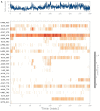Investigating the potential anticancer activities of antibiotics as topoisomerase II inhibitors and DNA intercalators: in vitro, molecular docking, molecular dynamics, and SAR studies
- PMID: 36701269
- PMCID: PMC9881673
- DOI: 10.1080/14756366.2023.2171029
Investigating the potential anticancer activities of antibiotics as topoisomerase II inhibitors and DNA intercalators: in vitro, molecular docking, molecular dynamics, and SAR studies
Abstract
Topoisomerase II (TOP-2) is a promising molecular target for cancer therapy. Numerous antibiotics could interact with biologically relevant macromolecules and provoke antitumor potential. Herein, molecular docking studies were used to investigate the binding interactions of 138 antibiotics against the human topoisomerase II-DNA complex. Followed by the MD simulations for 200 ns and MM-GBSA calculations. On the other hand, the antitumor activities of the most promising candidates were investigated against three cancer cell lines using doxorubicin (DOX) as a reference drug. Notably, spiramycin (SP) and clarithromycin (CL) showed promising anticancer potentials on the MCF-7 cell line. Moreover, azithromycin (AZ) and CL exhibited good anticancer potentials against the HCT-116 cell line. Finally, the TOP-2 enzyme inhibition assay was carried out to confirm the proposed rationale. Briefly, potent TOP-2 inhibitory potentials were recorded for erythromycin (ER) and roxithromycin (RO). Additionally, a SAR study opened eyes to promising anticancer pharmacophores encountered by these antibiotics.HighlightsMolecular docking studies of 139 antibiotics against the topoisomerase II-DNA complex.SP, RO, AZ, CL, and ER were the most promising and commercially available candidates.Molecular dynamics simulations for 200 ns for the most promising five complexes.MM-GBSA calculations for the frontier five complexes.SP and CL showed promising anticancer potentials on the MCF-7 cell line, besides, AZ and CL exhibited good anticancer potentials against the HCT-116 cell line.Potent TOP-2 inhibitory potentials were recorded for ER and RO.
Keywords: Antibiotics; MM-GBSA; cytotoxicity; molecular docking and dynamics; topoisomerase II.
Conflict of interest statement
The authors report no conflicts of interest.
Figures














Similar articles
-
Design, synthesis, molecular docking and anti-proliferative evaluations of [1,2,4]triazolo[4,3-a]quinoxaline derivatives as DNA intercalators and Topoisomerase II inhibitors.Bioorg Chem. 2020 Dec;105:104399. doi: 10.1016/j.bioorg.2020.104399. Epub 2020 Oct 21. Bioorg Chem. 2020. PMID: 33113414
-
Design and Discovery of Novel Quinoxaline Derivatives as Dual DNA Intercalators and Topoisomerase II Inhibitors.Anticancer Agents Med Chem. 2018;18(2):195-209. doi: 10.2174/1871520617666170710182405. Anticancer Agents Med Chem. 2018. PMID: 28699490
-
Discovery of novel triazolophthalazine derivatives as DNA intercalators and topoisomerase II inhibitors.Arch Pharm (Weinheim). 2021 Jun;354(6):e2000456. doi: 10.1002/ardp.202000456. Epub 2021 Feb 8. Arch Pharm (Weinheim). 2021. PMID: 33554352
-
Towards anticancer fluoroquinolones: A review article.Arch Pharm (Weinheim). 2019 Jul;352(7):e1800376. doi: 10.1002/ardp.201800376. Epub 2019 Jun 19. Arch Pharm (Weinheim). 2019. PMID: 31215674 Review.
-
Topoisomerases as anticancer targets.Biochem J. 2018 Jan 23;475(2):373-398. doi: 10.1042/BCJ20160583. Biochem J. 2018. PMID: 29363591 Free PMC article. Review.
Cited by
-
Exploring the anticancer and antioxidant properties of Lagerstroemia speciosa bark extract via phytochemical and molecular docking analysis.J Genet Eng Biotechnol. 2025 Sep;23(3):100553. doi: 10.1016/j.jgeb.2025.100553. Epub 2025 Aug 14. J Genet Eng Biotechnol. 2025. PMID: 40854670 Free PMC article.
-
Identification of potent inhibitors of HDAC2 from herbal products for the treatment of colon cancer: Molecular docking, molecular dynamics simulation, MM/GBSA calculations, DFT studies, and pharmacokinetic analysis.PLoS One. 2024 Jul 22;19(7):e0307501. doi: 10.1371/journal.pone.0307501. eCollection 2024. PLoS One. 2024. PMID: 39037973 Free PMC article.
-
Evaluating the ability of some natural phenolic acids to target the main protease and AAK1 in SARS COV-2.Sci Rep. 2023 May 5;13(1):7357. doi: 10.1038/s41598-023-34189-6. Sci Rep. 2023. PMID: 37147518 Free PMC article.
-
In Silico Molecular Docking Analysis, Cytotoxicity, and Antibacterial Activities of Constituents of Fruits of Cucumis dipsaceus.ACS Omega. 2023 Dec 19;9(1):1945-1955. doi: 10.1021/acsomega.3c08866. eCollection 2024 Jan 9. ACS Omega. 2023. PMID: 38222496 Free PMC article.
-
Design and statistical optimisation of emulsomal nanoparticles for improved anti-SARS-CoV-2 activity of N-(5-nitrothiazol-2-yl)-carboxamido candidates: in vitro and in silico studies.J Enzyme Inhib Med Chem. 2023 Dec;38(1):2202357. doi: 10.1080/14756366.2023.2202357. J Enzyme Inhib Med Chem. 2023. PMID: 37092260 Free PMC article.
References
-
- Häder D-P, Williamson CE, Wängberg S-Å, Rautio M, Rose KC, Gao K, Helbling EW, Sinha RP, Worrest R.. Effects of UV radiation on aquatic ecosystems and interactions with other environmental factors. Photochem Photobiol Sci. 2015;14(1):108–126. - PubMed
MeSH terms
Substances
LinkOut - more resources
Full Text Sources
Other Literature Sources
Research Materials
Miscellaneous
